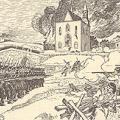 THE REBELLIONS OF 1837-1838
THE REBELLIONS OF 1837-1838
In 1837 and 1838, Lower and Upper Canada were rocked by tremendous social and political upheavals. Known as "The Rebellions," these upheavals were more profoundly felt in Lower Canada (Quebec), where Louis-Joseph Papineau and his Patriote Party dominated both the Legislative Assembly and the movement for political reform. The Patriotes, composed in large part (but not entirely) of French Canadians, found themselves increasingly opposed to the conservative English Canadian and British leadership of the province.
THE TOWNSHIPS
The violent clashes along the Richelieu River, St-Eustache, and elsewhere, have been well recounted before. What is of interest to us here is that both the reform movement and the Rebellions that followed had a distinctive Eastern Townships aspect to them.
In the mid-1830s, the border counties of Missisquoi and Stanstead each sent reformers to the Legislative Assembly in Quebec City. But in 1837, when the more radical members of the province's reform movement turned to open rebellion, the entire movement (including its more moderate members) was implicated.
AMERICAN ORIGINS
A number of Members of the Legislative Assembly (MLAs) from the Eastern Townships were of American origin. This is not surprising, since much of the region at this time was populated by American-born and American-descended people. Notwithstanding the popular myth that the Townships were populated by United Empire Loyalists clinging to the British monarchy, attachments to the United States were very strong, and many recent immigrants or their children actually favoured the democratic ideals of the American Revolution.
 THE RIGHTS OF THE PEOPLE
THE RIGHTS OF THE PEOPLE
Stanstead County's MLA Marcus Child, who was born in Massachusetts, openly sided with Papineau. In the Assembly, Child voted for Papineau's famous Ninety-Two Resolutions, which listed all of the party's demands and grievances against the government. Child declared himself "a firm supporter of the Chartered Rights of the People."(1) These were strong statements in a province that was still a long way from democracy, but they seemed to appeal to many of the common farmers and tradesmen of the Townships.
A number of reformist newspapers were active in the Townships during this period. In Stanbridge East, government troops reputedly tossed the presses of the Missisquoi Post into the Pike River. The St. Francis Courier, printed in Sherbrooke, was another paper of this stripe. And The Canadian Patriot (Stanstead) was a particularly radical broadsheet which, during the Rebellions, was actually printed across the border in the safety of Derby Line, Vermont. Its publisher, wrote Townships historian B. F. Hubbard, was dedicated "to stirring up the people to revolt."(2)
REFORMERS AND CONSTITUTIONALISTS
Reform associations were formed in many townships, and speeches at these meetings were reported in local and Montreal newspapers in the years leading up to the first outbreak of the Rebellions in November 1837. People in the Townships were becoming very highly politicized.
"Loyal" or constitutional associations had their adherents in the region, as well. Many respected, influential business and political leaders were in this camp, among them Joseph Walton, the outspoken publisher of the Sherbrooke newspaper, the Farmers' Advocate and Townships Gazette. Some Townshippers demonstrated their loyalty by serving in the local militia, which would ultimately help maintain order in the Townships during and after the Rebellions.
(Continued in The Rebellions Part II: Hunters' Lodges and the "Loyal" Reaction)
References:
1) Matthew Farfan, The Stanstead Region, 1792-1844, Ottawa, 1992, 48.
2) B. F. Hubbard, Forests and Clearings, Montreal, 1874, 12-16. Hubbard was quoting Joseph Walton, another militia volunteer.